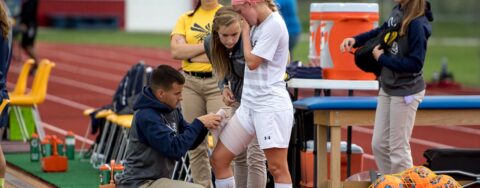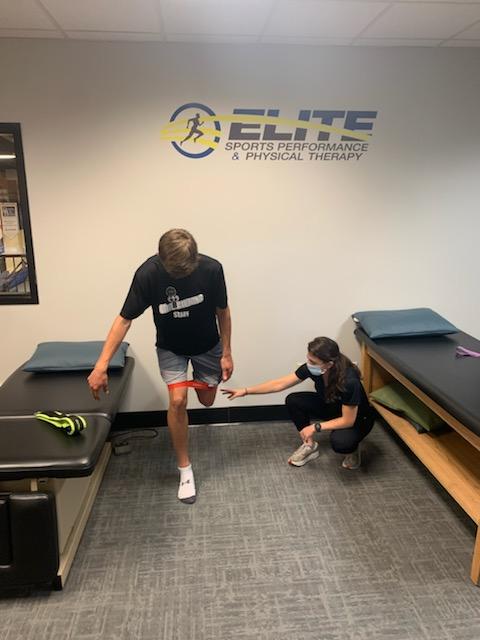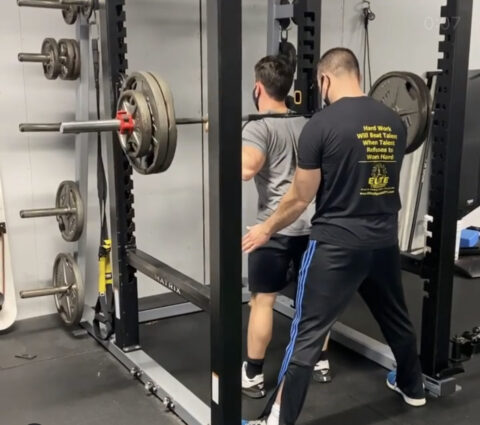March Is National Athletic Training Month

It is a sunny November afternoon, and you are playing soccer for your high school varsity soccer team. It is a tied game and a win will clinch a playoff spot and move you one step closer to winning the league championship. You are in the middle of the field and your teammate steals the ball and is now on a counter attack. You quickly change direction and plant your right foot down on the ground, but the momentum of your body is too strong and you hear a “pop” and you collapse to the ground. Thoughts are racing through your head, “Oh no, what was that?”… “there was no one near me, how did I even fall down?!”… “I can get up, I’m fine”… “Nope, actually this really hurts…” The referee finally blows the whistle to stop the clock and calls out your coach to the field. Side by side with your coach comes your team’s Athletic Trainer (AT). The AT begins asking all sorts of questions…“Where does it hurt?”… “What was the motion that you did right before you went down and felt pain”… “Did you hear any sounds”… All while trying their best to keep you calm, “keep breathing”… “take a deep breath for me”… “we are going to take our time until you are ready.”
March is National Athletic Training Month and to highlight the Athletic Trainers in our community this month, we wanted to look at the role of the AT and how they play a critical role in your athletic department. We will also cover the importance of communication after an injury between the athlete, athletic trainer, physical therapist, and strength and conditioning coach.
Before diving any further, here are the roles and responsibilities of each professional that will be part of an athlete’s rehabilitation process.
Athletic Trainers (ATs) are licensed medical professionals who are nationally board-certified through the National Athletic Training Association and have received the minimum of a bachelor’s degree in Athletic Training (many have their masters degrees) and are responsible for evaluating, treating, and rehabilitating athletes with an injury. The AT performs his/her duties under direct guidance from a supervising team physician. An AT is also the point person/liaison between the medical team and coach as well as the medical team and the athlete.
Physical Therapists (PTs) are also licensed medical professionals and often work with patients of all ages, including athletes of all ages and from children to older adults, to treat a variety of musculoskeletal, neurological, and other types of injuries and conditions. Depending on when they graduated, PTs have received their Doctorate, Masters, or BS degree in Physical Therapy and are licensed through their state’s Department of Allied Health Professionals. PTs aid in the rehabilitation process of the athlete by assessing and evaluating the patient, observing and assessing movement patterns affected by an injury or medical condition, and developing a comprehensive rehab plan of care for the athlete. Depending on the injury and the current situation of the athletic training department, athletes may perform their rehabilitation with a PT or an AT for the majority of their plan of care. To meet some of Elite’s PT staff, click HERE.

Strength and Conditioning Specialists (CSCS) are nationally-certified through the National Strength and Conditioning Association. Most certified strength coaches also have a BS in Exercise Science, Physical Education, or a similar field. A strength and conditioning coach develops and implements a program with the goal of improving strength, speed, power, conditioning, and overall sports performance for an athlete or team. To learn more about Elite’s Strength & Conditioning Coaches, visit HERE.

Like any team, the athletic trainer, physical therapist, and strength and conditioning coach prioritize communication with each other to ensure that the athlete is receiving the proper care and returning to their sport as safely and quickly as possible. As mentioned before, the AT is the driving force behind the communication between all parties involved. The goal of the communication is for the AT to express their knowledge in rehab that can be used in their strength and conditioning programs. As the athlete progresses through their rehabilitation, the AT communicates frequently with the athlete’s head coach to inform of what the athlete is cleared to do in practice and when they are fully cleared to participate in competition. The reason for the communication to and from the AT is quite simple: “the right hand needs to know what the left hand is doing.” The constant communication allows for both parties to know what the other is doing and they can work together to create a plan of care with the best interest of the athlete in mind.
Communication Is Key!
Communication is not only just important within the medical staff and those involved with the treatment plan, but also is crucial for the AT to be in constant communication with the athlete. This allows for the athlete to inform the AT if there are any flare ups in the treatment plan that may result in a setback, but also lets the AT know when the athlete is getting closer to returning to play. Creating a strong relationship with the AT creates a strong line of trust. An AT also has the advantage of seeing the athlete every day when a PT may see the athlete once or twice a week and the treating physician may see the athlete once at the beginning and not again for another 6 weeks. This creates accountability for the athlete to complete his necessary treatment to return to playing and is receiving a structured plan of care by a trained professional.
It has been commonly misunderstood that the AT is only for those who are severely injured, when in reality, they are a resource for so much more. ATs would prefer an athlete visit them with a small injury for treatment to avoid the injury becoming any worse and potentially sidelining the athlete. ATs can also provide guidance for injury prevention, conditioning, nutrition, wellness promotion, and education.
Don’t Let Small Things Become Big Things!
After discussing with a few athletic trainers what to add to this blog, many responded back with the importance of athletes building relationships with their athletic trainer before they are injured. This can certainly be difficult with the time constraints of being a student athlete, but the reward of having a strong relationship with your AT when you need it will be worth it. Once you are injured, visit your AT and explain your situation. The AT will then get the ball rolling on what is the next step in your plan of care. Sometimes this means you get your ankle taped, sometimes they recommend you go to urgent care for an x-ray, and other times they may recommend you consult with a physician or PT and the AT can use their resources to schedule the appointment for you.
Your AT does a lot more than make a bag of ice or tape your wrist before a game; they are trained and licensed to evaluate and treat injuries, be a listening ear when you need to get something off your chest, and in the rare circumstance, they can save your life. Athletic Trainers are undervalued and underappreciated so please be sure to thank your Athletic Trainer, wish them a happy National Athletic Training Month and let them know you appreciate them!
We hope you enjoyed this installment of our Sports Performance blog series! If you or an athlete in your family would like to join the Elite Sports Performance community and elevate your game to a new level, we offer Sports Performance and Athlete Training programs at both our Foxboro and Stoughton locations. To learn more about our programs for athletes of all ages and sports and how YOU can improve your acceleration, strength, power and performance in the process, click HERE or email us at EliteSPC@EliteFitCenter.com!

